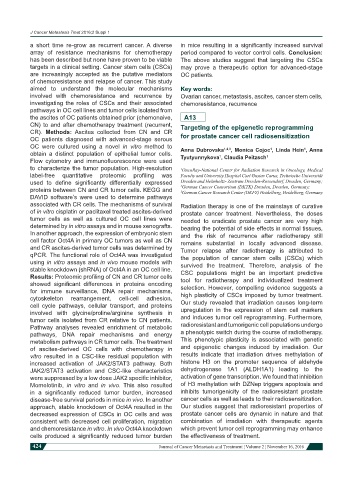Page 434 - Read Online
P. 434
J Cancer Metastasis Treat 2016;2 Suppl 1
a short time re-grow as recurrent cancer. A diverse in mice resulting in a significantly increased survival
array of resistance mechanisms for chemotherapy period compared to vector control cells. Conclusion:
has been described but none have proven to be viable The above studies suggest that targeting the CSCs
targets in a clinical setting. Cancer stem cells (CSCs) may prove a therapeutic option for advanced-stage
are increasingly accepted as the putative mediators OC patients.
of chemoresistance and relapse of cancer. This study
aimed to understand the molecular mechanisms Key words:
involved with chemoresistance and recurrence by Ovarian cancer, metastasis, ascites, cancer stem cells,
investigating the roles of CSCs and their associated chemoresistance, recurrence
pathways in OC cell lines and tumor cells isolated from
the ascites of OC patients obtained prior (chemonaive, A13
CN) to and after chemotherapy treatment (recurrent, Targeting of the epigenetic reprogramming
CR). Methods: Ascites collected from CN and CR
OC patients diagnosed with advanced-stage serous for prostate cancer cell radiosensitization
OC were cultured using a novel in vitro method to Anna Dubrovska 1,2,3 , Monica Cojoc , Linda Hein , Anna
1
1
obtain a distinct population of epithelial tumor cells. Tyutyunnykova , Claudia Peitzsch 1
1
Flow cytometry and immunofluorescence were used
to characterize the tumor population. High-resolution 1 OncoRay-National Center for Radiation Research in Oncology, Medical
label-free quantitative proteomic profiling was Faculty and University Hospital Carl Gustav Carus, Technische Universität
used to define significantly differentially expressed Dresden and Helmholtz- Zentrum Dresden-Rossendorf, Dresden, Germany;
2
proteins between CN and CR tumor cells. KEGG and 3 German Cancer Consortium (DKTK) Dresden, Dresden, Germany;
German Cancer Research Center (DKFZ) Heidelberg, Heidelberg, Germany
DAVID software’s were used to determine pathways
associated with CR cells. The mechanisms of survival Radiation therapy is one of the mainstays of curative
of in vitro cisplatin or paclitaxel treated ascites-derived prostate cancer treatment. Nevertheless, the doses
tumor cells as well as cultured OC cell lines were needed to eradicate prostate cancer are very high
determined by in vitro assays and in mouse xenografts. bearing the potential of side effects in normal tissues,
In another approach, the expression of embryonic stem and the risk of recurrence after radiotherapy still
cell factor Oct4A in primary OC tumors as well as CN remains substantial in locally advanced disease.
and CR ascites-derived tumor cells was determined by Tumor relapse after radiotherapy is attributed to
qPCR. The functional role of Oct4A was investigated the population of cancer stem cells (CSCs) which
using in vitro assays and in vivo mouse models with survived the treatment. Therefore, analysis of the
stable knockdown (shRNA) of Oct4A in an OC cell line. CSC populations might be an important predictive
Results: Proteomic profiling of CN and CR tumor cells tool for radiotherapy and individualized treatment
showed significant differences in proteins encoding
for immune surveillance, DNA repair mechanisms, selection. However, compelling evidence suggests a
cytoskeleton rearrangement, cell-cell adhesion, high plasticity of CSCs imposed by tumor treatment.
cell cycle pathways, cellular transport, and proteins Our study revealed that irradiation causes long-term
involved with glycine/proline/arginine synthesis in upregulation in the expression of stem cell markers
tumor cells isolated from CR relative to CN patients. and induces tumor cell reprogramming. Furthermore,
Pathway analyses revealed enrichment of metabolic radioresistant and tumorigenic cell populations undergo
pathways, DNA repair mechanisms and energy a phenotypic switch during the course of radiotherapy.
metabolism pathways in CR tumor cells. The treatment This phenotypic plasticity is associated with genetic
of ascites-derived OC cells with chemotherapy in and epigenetic changes induced by irradiation. Our
vitro resulted in a CSC-like residual population with results indicate that irradiation drives methylation of
increased activation of JAK2/STAT3 pathway. Both histone H3 on the promoter sequence of aldehyde
JAK2/STAT3 activation and CSC-like characteristics dehydrogenase 1A1 (ALDH1A1) leading to the
were suppressed by a low dose JAK2 specific inhibitor, activation of gene transcription. We found that inhibition
Momelotinib, in vitro and in vivo. This also resulted of H3 methylation with DZNep triggers apoptosis and
in a significantly reduced tumor burden, increased inhibits tumorigenicity of the radioresistant prostate
disease-free survival periods in mice in vivo. In another cancer cells as well as leads to their radiosensitization.
approach, stable knockdown of Oct4A resulted in the Our studies suggest that radioresistant properties of
decreased expression of CSCs in OC cells and was prostate cancer cells are dynamic in nature and that
consistent with decreased cell proliferation, migration combination of irradiation with therapeutic agents
and chemoresistance in vitro. In vivo Oct4A knockdown which prevent tumor cell reprogramming may enhance
cells produced a significantly reduced tumor burden the effectiveness of treatment.
424
Journal of Cancer Metastasis and Treatment ¦ Volume 2 ¦ November 16, 2016

